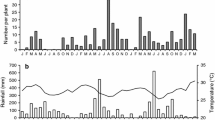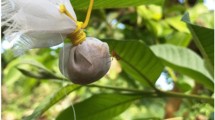Abstract
The effectiveness of inundative releases of four strains of the egg parasiteTrichogramma (Hymenoptera, Trichogrammatidae) to control five lepidopterous species infesting Brussels sprouts crops in the Netherlands was examined in small-scale field experiments in 1982–1985. Strains were selected on the basis of behavioural characteristics investigated in laboratory experiments, i.e. parasitization activity at low temperature and host-species preference.Mamestra brassicae (Noctuidae) was the most abundant host species. Its density usually averaged between 0.5 and 2.0 eggs/plant throughout most of the season (June–September). A very high peak density of 12 eggs/plant occurred in 1982. In other years the peak was below 2.5 eggs/plant.
Correspondence between the observed patterns of parasitism and behavioural characteristics of the strains was in general present. A strain ofT. evanescens (no. 57), with a high activity at 12°C, performed best againstM. brassicae. However, even its highest rate of parasitism (52%) was not sufficiently effective. A strain ofT. maidis (no. 11) performed best againstPieris brassicae andP. rapae (Pieridae), but parasitism remained low (<30%) and was generally limited to peak densities (<0.5 eggs plant) occurring in 1982 and 1985.Plutella xylostella (Yponomeutidae) was an abundant species in some years, but parasitism of its eggs was never observed. Egg densities ofEvergestis forficalis (Pyralidae) remained low in all years. The relationship between parasitims and host density and the influence of the parasite-release rate are discussed. Low host densities may have been a limiting factor for effective parasitism.
Samenvatting
In spruitkool kan schade veroorzaakt worden door rupsen van vijf soorten Lepidoptera. Inundatieve biologische bestrijding met de eiparasietTrichogramma (Hymenoptera, Trichogrammatidae) zou een alternatief kunnen zijn voor intensieve chemische gestrijding. In veldexperimenten (1982–1985) is de effectiviteit van vierTrichogramma spp. stammen vergeleken om de uitkomsten van laboratoriumonderzoek naar criteria voor de selectie van geschikte natuurlijke vijanden te evalueren. Selectiecriteria zijn gebaseerd op eigenschappen van het zoek- en parasiteringsgedrag van de parasieten, o.a. parasiteringsactiviteit bij lage temperatuur en gastheer-preferentie.
Mamestra brassicae (Noctuidae) was de talrijkste gastheersooort, met een gemiddelde dichtheid van 0,2–2,0 eieren/plant gedurende een groot deel van het seizoen (juni–september). Een extreem hoge piekdichtheid (12 eieren/plant) deed zich voor in 1982. In andere jaren was de piekdichtheid ongeveer 2,5 eieren/plant. Eieren vanM. brassicae werden het meest geparasiteerd door stam 57 (T. evanescens), maar zelfs het hoogste gemiddelde seizoenspercentage parasitisme (52%) was niet voldoende voor een effectieve bestrijding. EenT. maidis stam (11) gaf de beste resultaten tegenPieris brassicae enP. rapae (Pieridae), maar parasitisme was laag (<30%) en vrijwel beperkt tot piekdichtheden hoger dan 0,5 eieren/plant, die voorkwamen in 1982 en 1985.Plutella xylostella (Plutellidae) was soms talrijk, maar eiparasitisme leek niet voor te komen. De dichtheid vanEvergestis forficalis (Pyralidae) was gering in alle jaren.
Relatief lage gastheerdichtheden kunnen een beperkende factor geweest zijn voor het optreden van een effectieve percentages eiparasitisme. De resultaten tonen aan dat er een overeenstemming is tussen selectiecriteria die in het laboratorium zijn onderzocht en de effectiviteit van geselecteerde stammen in het veld.
Similar content being viewed by others
References
Alebeek, F.A.N. van, Pak, G.A., Hassan, S.A. & Lenteren, J.C. van, 1986. Experimental releases ofTrichogramma spp. against lepidopteran pests in a cabbage field crop in the Netherlands in 1985. Mededelingen Faculteit voor Landbouwwetenschappen Rijksuniversiteit Gent 51: 1017–1028.
Bigler, F., 1986. Mass-production ofTrichogramma maidis Pint. et Voeg. and its field application againstOstrinia nubilalis Hbn. in Switzerland. Journal of applied Entomology 101: 23–29.
Chesson, J., 1982. Estimation and analysis of parasitoid search and attack parameters from field data. Environmental Entomology 11: 531–537.
Cochran, W.G., 1977. Sampling Techniques. Third edition. Wiley, New York.
Dijken, M.J. van, Kole, M., Lenteren, J.C. van & Brand, A.M., 1986. Host-preference studies withTrichogramma evanescens Westwood (Hym., Trichogrammatidae) forMamestra brassicae, Pieris brassicae andPieris rapae. Journal of applied Entomology 101: 64–85.
Glas, P.C.G., Smits, P.H., Vlaming, P. & Lenteren, J.C. van, 1981. Biological control of lepidopteran pests in cabbage crops by means of inundative releases ofTrichogramma species (T. evanescens Westwood andT. cacoeciae March): A combination of field and laboratory experiments. Mededelingen Faculteit voor Landbouwwetenschappen Rijksuniversiteit Gent 46: 487–497.
Gross, H.R., 1981. Employment of kairomones in the management of parasitoids. In: D.A. Nordlund, R.J. Jones & W.J. Lewis (Eds), Semiochemicals, their role in pest control. Wiley, New York, p. 137–152.
Hassan, S.A., 1981. Mass-production and utilization ofTrichogramma. 2. Four years succesful biological control of the European corn borer. Mededelingen Faculteit voor Landbouwwetenschappen Rijksuniversiteit Gent 46: 417–427.
Hassan, S.A., 1982. Mass-production and utilization ofTrichogramma. 3. Results of some research projects related to the practical use in the Federal Republic of Germany. In: Les Trichogrammes, Antibes, France, 1982. Les colloques de l'INRA 9, p. 213–218.
Hassan, S.A., Langenbruch, G.A. & Neuffer, G., 1978. Der Einfluß des Wirtes in der Massenzucht auf die Qualität des EiparasitenTrichogramma evanencens bei der Bekämpfung des MaiszünslersOstrinia nubilalis. Entomophaga 23: 312–329.
Hassan, S.A. & Rost, W.M. 1985. Mass-production and utilization ofTrichogramma. 6. Studies towards the use against cabbage lepidopterous pests. Mededelingen Faculteit voor Landbouwwetenschappen Rijksuniversiteit Gent: 389–398.
Hirose, Y., Kimoto, H. & Hiehata, K., 1976. The effect of host aggregation on parasitism byTrichogramma papilionis, an egg parasite ofPapilio xuthus. Japanese Journal of Applied Entomology and Zoology 11: 116–125.
Houseweart, M.W., Jennings, D.T. & Lawrence, R.K., 1984. Field releases ofTrichogramma minutum (Hymenoptera: Trichogrammatidae) for suppression of epidemic spruce budworm,Choristoneura fumiferana (Lepidoptera: Tortricidae), egg populations in Maine. Canadian Entomologist 116: 1357–1366.
Knipling, E.F. & Mcguire, J.V., 1968. Population models to appraise the limitations and potentialities ofTrichogramma in managing host insect populations. United States Department of Agruculture Technical Bulletin Number 1387.
Kot, J., 1964. Experiments in the biology and ecology of species of the genusTrichogramma Westw. and their use in plant protection. Ekologia Polska A 12: 243–303.
Kot, J., 1979. Analysis of factors affecting the phytophage reduction byTrichogramma Westw. species. Polish Ecological Studies 5: 5–59.
Lenteren, J.C., van, 1980. Evaluation of control capabilities of natural enemies: Does art have to become science. Netherlands Journal of Zoology 30: 369–381.
Lenteren, J.C. van, Glas, P.C.G. & Smits, P.H., 1982. Evaluation of control capabilities ofTrichogramma and results of laboratory and field research onTrichogramma in the Netherlands. In: Les Trichogrammes. Antibes, France, 1982. Les colloques de l'INRA 9, p. 257–268.
Morrison, G., Lewis, W.J. & Nordlund, D.A. 1980. Spatial differences inHeliothis zea egg density and the intensity of parasitism byTrichogramma spp.: an experimental analysis. Environmental Entomology 9: 79–85.
Nagarkatti, S. & Nagaraja, H., 1977. Biosystematics ofTrichogramma andTrichogrammatiodea species. Annual Review of Entomology 22: 157–176.
Pak, G.A., 1988. Selection ofTrichogramma for inundative biological control. Doctorate Thesis, Agricultural University Wageningen, the Netherlands, p. 81–105.
Pak, G.A., Buis, H.C.E.M., Heck, I.C.C. & Hermans, M.G.L., 1986. Behavioural variations among strains ofTrichogramma spp.: Host-age selection. Entomologia Experimentalis et Applicata 40: 247–258.
Pak, G.A. & Heiningen, T.G. van, 1985. Behavioural variations among strains ofTrichogramma spp.: Adaptability to field-temperature conditions. Entomologia Experimentalis et Applicata 38: 3–13.
Pak, G.A. & Jong, E.J. de, 1987. Behavioural variations among strains ofTrichogramma spp.: Host recognition. Netherlands Journal of Zoology 37: 137–166.
Pak, G.A. & Lenteren, J.C. van, 1984. Selection of a candidateTrichogramma spp. strain for inundative releases against Lepidopterous pests of cabbage in the Netherlands. Mededelingen Faculteit voor Landbouwwetenschappen Rijksuniversiteit Gent 49: 827–837.
Parker, F.D., 1970. Seasonal mortality and survival ofPieris rapae in Missouri and the effects of introducing an egg parasite,Trichogramma evanescens. Annals of the Entomological Society of America 63: 985–994.
Parker, F.D., Lawson, F.R. & Pinnell, R.E., 1971. Suppression ofPieris rapae utilizing a new control system: Mass releases of both the pest and its parasites. Journal of Economic Entomology 64: 721–735.
Pena, J.E. & Waddill, V., 1983. Larval and egg parasitism ofKeiferia lycopersicella (Walsingham) (Lepidoptera: Gelechiidae) in Southern Florida tomato fields. Environmental Entomology 12: 1322–1326.
Ridgway, R.L., Ables, J.R., Goodpasture, C. & Hartsack, A.W., 1981.Trichogramma and its utilization for crop protection in the USA. In: Proc. Joint American-Soviet Conference on use of beneficial organisms in the control of crop pests, Washington D.C., 1979. Entomological Society of America Bulletin 1387: 41–48.
Schaaf, D.A. van der, Kaskens, J.W.M., Kole, M., Noldus, L.P.J.J. & Pak, G.A., 1984. Experimental releases of two strains ofTrichogramma spp. against Lepidopteran pests in Brussels sprouts field crop in the Netherlands. Mededelingen Faculteit voor Landbouwwetenschappen Rijksuniversiteit Gent. 49: 803–813.
Shcheptilnikova, V.A., 1974. Use ofTrichogramma in the U.S.S.R. In: Shumakov, E.M., Gusev, G.V. & Fedorinchik, N.S. (Eds), Biological agents for plant protection. Kolos, Moscow, p. 160–182.
Smith, S.M., Hubbes, M. & Carrow, J.R., 1986. Factors affecting inundative releases ofTrichogramma minutum against the Spruce Budworm. Journal of Applied Entomology 101: 29–38.
Stinner, R.E., 1977. Efficacy of inundative releases. Annual Review of Entomology 22: 515–531.
Theunissen, J. & Ouden, H. den, 1983. Comparison of sampling methods for insect pests in Brussels sprouts. Mededelingen Faculteit voor Landbouwwetenschappen Rijksuniversiteit Gent 48: 281–286.
Theunissen, J. & Ouden, H. den, 1985. Tolerance levels for supervised control of insect pests in Brussels sprouts and white cabbage. Zeitschrift für Angewandte Entomologie 100: 84–87.
Voronin, K.E. & Grinberg, A.M., 1981. The current status and prospects ofTrichogramma utilization in the U.S.S.R. In: Proc. Joint American-Soviet Conference on use of beneficial organisms in the control of crop pests, Washington D.C., 1979. Entomological Society of America Bulletin 1387, p. 49–51.
Wit, A.K.H., 1982. The relation between artificial defoliation and yield in Brussels sprouts as a method to assess quantitative damage induced by leaf eating insects. Zeitschrift für Angewandte Entomologie 94: 425–431.
Author information
Authors and Affiliations
Rights and permissions
About this article
Cite this article
Pak, G.A., Van Heiningen, T.G., Van Alebeek, F.A.N. et al. Experimental inundative releases of different strains of the egg parasite Trichogramma in Brussels sprouts. Netherlands Journal of Plant Pathology 95, 129–142 (1989). https://doi.org/10.1007/BF01999968
Accepted:
Issue Date:
DOI: https://doi.org/10.1007/BF01999968




